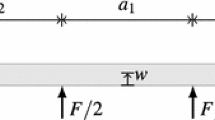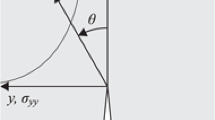Abstract
The strength of wood is reduced when the stressed volume is increased. The phenomenon is termed size effect and is often explained as being stochastic in the sense that the probability of weak locations occurring in the wood increases with increased volume. This paper presents the hypothesis that the lower strength is caused by stress concentrations. The stress concentrations arise from the anisotropic structure of wood, and are therefore deterministic. The hypothesis is substantiated through extensive FEM-calculations and experiments. A reasonable agreement between ultimate stresses determined experimentally and in FEM-computations was found.













Similar content being viewed by others
References
Aicher S, Dill-Langer G (1996) Influence of cylindrical anisotropy of wood and loading conditions on off-axis stiffness and stresses of a board in tension perpendicular to grain. Otto Graf J 7:216–242
Aicher S, Dill-Langer G, Ranta-Maunus A (1998) Duration of load effect in tension perpendicular to the grain of glulam in different climates. Holz Roh- Werkst 56:295–305
EN 408 (2003) Timber structures – structural timber and glued laminated timber – determination of some physical and mechanical properties
Gustafsson PJ (2002) Fracture perpendicular to grain – structural applications. In: Thelanderson S, Larsen HJ (eds) Timber engineering. Wiley, England, pp 103–130
Hanhijärvi A, Ranta-Maunus A (1996) Computational analysis of transverse anisotropy and annual ring pattern in cross-sections of curved glulam beams on the size effect of strength. In: Proceedings of the European workshop on application of statistics and probabilities in wood mechanics, Bordeaux, France, February 22–23
Hoffmeyer P, Damkilde L, Pedersen TN (2000) Structural timber and glulam in compression perpendicular to grain. Holz Roh- Werkst 58:73–80
Pedersen MU, Clorius CO, Damkilde L, Hoffmeyer P (2003) A simple size effect model for tension perpendicular to the grain. Wood Sci Technol 37:125–140
Smith I, Landis E, Gong M (2003) Fracture and fatigue in wood. Wiley, England
Acknowledgments
This project was partly sponsored by the Danish Research Agency, “DSF project 2020-00-0017”. We gratefully acknowledge this contribution.
Author information
Authors and Affiliations
Corresponding author
Rights and permissions
About this article
Cite this article
Astrup, T., Clorius, C.O., Damkilde, L. et al. Size effect of glulam beams in tension perpendicular to grain. Wood Sci Technol 41, 361–372 (2007). https://doi.org/10.1007/s00226-006-0113-6
Received:
Published:
Issue Date:
DOI: https://doi.org/10.1007/s00226-006-0113-6




